OverviewThe Agent Desktop Native (ADN) application, supported by LiveVox U10 and above versions, is an installable application designed to enhance the agent experience by offering the following features:- Browser-independent access to the Agent Desktop
- Integrated voice through WebRTC
- Access to screen recording
- Desktop Native commands enablement
This document provides a summary of changes across different releases and instructions to download, install, configure, and use the Agent Desktop Native application. This This document is intended for individuals responsible for the setup and training of contact center agents, and individuals who have access to the Agent Desktop configurations. | Note |
|---|
| The Agent Desktop Native application supports Windows 8.1+, Mac OS 10.9+, and Linux Debian 8. This document provides instructions for installation on Windows and Mac systems. |
Summary of ChangesThe below table summarizes the changes to the Agent Desktop Native application across different releases. | Scroll Table Layout |
|---|
| orientation | portrait |
|---|
| sortDirection | ASC |
|---|
| repeatTableHeaders | default |
|---|
| widths | 15%,15%,55%,15% |
|---|
| sortByColumn | 1 |
|---|
| tableStyling | confluence |
|---|
| sortEnabled | false |
|---|
| cellHighlighting | true |
|---|
|
| ADN Version | Platform Release | Changes | Release Date |
|---|
| 7.2 | U10 | - Supports the Copy to Clipboard feature which enables you to copy the contact manager fields and Call Flow variables and paste them to the destination.
- Enhanced keystroke emulation sequence support.
| December 13, 2019 | | 7.3 | U12 | - Supports installation of the Agent Desktop Native application using Group Policies (GPO) on the standard windows installer path.
| Note |
|---|
| Contact your internal IT team for the Microsoft installer (MSI) package required to install the Agent Desktop Native application. |
| January 28, 2020 | | 7.4 | U15 | - For ADN mass installation, MSI package can be used which supports provisioning using config.mst and config.json files. For more information,
| See Installing - See Installing the Agent Desktop Native Application using MSI Package section.
| Note |
|---|
| Contact the Customer Care Team for the MSI installer package required to install the Agent Desktop Native application. |
- ADN icon is now available in the System Tray.
- ADN can be configured for incoming call pop-up notifications with the U15 platform.
| December 22, 2020 | | 7.5 | U16 | - Ensures ADN adheres to Whitelist IP settings as configured in the LiveVox Portal'
| s | tab- tab.
- You can view PDF files from links shared on the agent chat or email through ADN.
| February 10, 2021 |
| Note |
|---|
| LiveVox U10 to U15 releases work with ADN 7.3. Before upgrading to these releases, please ensure your Agent Desktop Native version is upgraded to ADN 7.3. |
Downloading and Installing the Agent Desktop Native Application You can download the Agent Desktop Native application v7.5 on the agent’s station either through the LiveVox portal, Agent Sign In page, or by contacting the LiveVox Customer Care. Downloading the Agent Desktop Native ApplicationLiveVox Portal To download the Agent Desktop Native application through the LiveVox portal:- Login to the LiveVox portal with an account that has administrator privileges and navigate to to Configure > Agents > Agent Desktop > Desktop Native Native tab.
- Scroll down to the the Desktop Native Commands section section and choose a platform (Windows, Mac, or Linux) for which you want to download the Agent Desktop Native application.
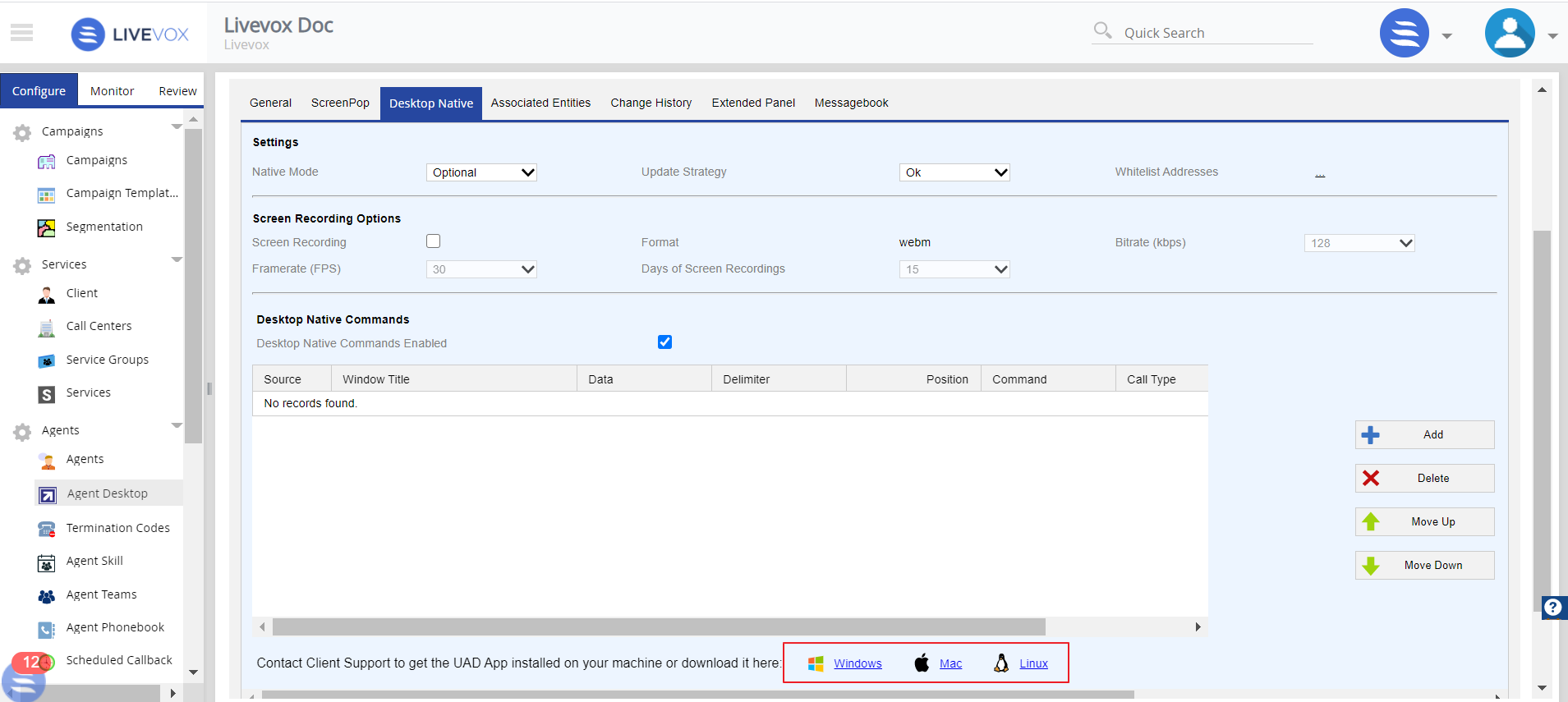
Agent Sign In PageTo download the Agent Desktop Native application through the Agent Sign In page, navigate to the Agent Sign In page, sign in with your credentials, and then click the the Get The App link link. 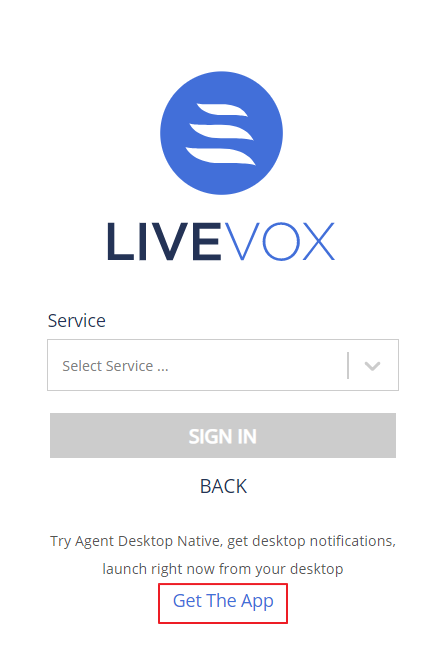 Image Modified Image Modified
| Note |
|---|
| Your browser automatically detects your operating system’s correct download file. |
Installing the Agent Desktop Native Application on WindowsTo install the Agent Desktop Native application on a Windows system, follow the procedure below:- Run the the agent-desktop-native-<version>.exe file file to launch the installer. The following message appears.
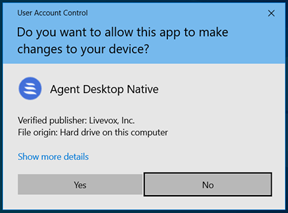 - Click the the Yes button button to begin the installation process. An Agent Desktop Native Setup window appears.
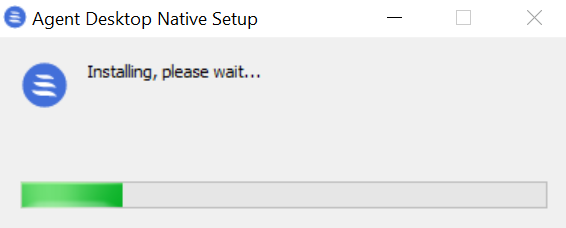 - The application installs on the local machine. You can launch the Agent Desktop Native application from the applications folder, or the icon placed on the desktop.

Installing the Agent Desktop Native Application using MSI PackageFor ADN mass installation, MSI installer package can be used which supports provisioning using config.mst and config.json files. | Note |
|---|
- This is applicable only to the Windows platform.
- Contact the Customer Care Team for the MSI installer package required to install the Agent Desktop Native application.
|
- Copy the Microsoft installer package ADN 7.5.msi and config.mst file to the specific folder. For Example, C:\temp\ADNInstall\
- Create the config.json file using notepad in the same folder
with - with the below contents. Update
the - the Value
with - with your appropriate Client code.
{"clientCode":"Value"} - Open the windows cmd prompt and go the MSI package directory. For Example, cd C:\temp\ADNInstall\
- Execute the below command:
msiexec /i agent-desktop-native-7.5.0.msi TRANSFORMS=config.mst
Installing the Agent Desktop Native Application on Mac - After downloading the Agent Desktop Native application, run the the .pkg file file to launch the installer.
- Follow the installation on-screen instructions to complete the installation process.
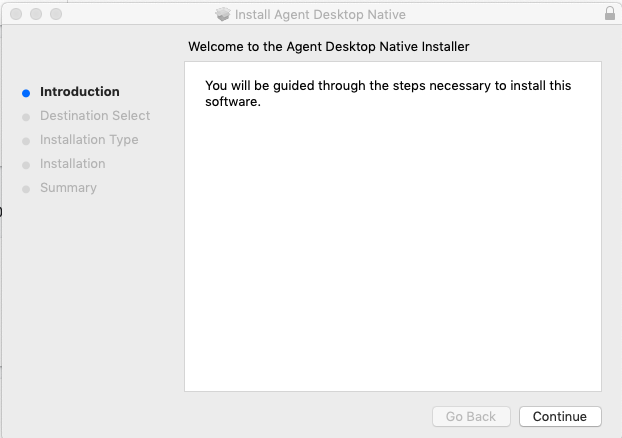 Image Modified Image Modified
After the installation process is complete, launch the Agent Desktop Native application from the applications folder.
Configuring the Agent Desktop Native Application You can configure the Agent Desktop Native settings on the the Configure tab tab of the LiveVox portal. Login to the LiveVox portal with an account that has administrator privileges and navigate to to Configure > Agents > Agent Desktop > Desktop Native.On the LiveVox U10 platform and above versions, the the Desktop Native tab tab is available by default in the Agent Desktop screen of the voice portal. - Click the the Associated Entities Entities tab and ensure that the selected desktop is associated with the service to which the agent must log in. You can configure the association in the Client or Service editorthe Client or Service editor.
 - On the the Desktop Native tab tab, ensure that the the Native Mode is is set to Optional or to Optional or Required. The The Native Mode drop drop-down menu has the following options:
- Disabled Disabled - Agent cannot log in using ADN
- Optional Optional - Agent can use the browser or ADN to log in
- Required Required - Agent can log in only using ADN

- Choose an an Update Strategy to to define the version of the Agent Desktop Native application:
- Ok - No restriction to use any version of ADN
- Ask - If an agent has a different version installed than the one configured for the site, a pop-up prompting an update appears. An update notification appears after the agent logs in to the Agent Desktop Native application and selects a service.
 - Force Force - After login, the update process installs and starts the new version without intervention. The update automatically launches when an agent logs in to the Agent Desktop Native application and selects a service.
 Image Modified Image Modified
- Set Whitelist Addresses to define trusted domains. If the domain is not added in the Whitelist address list, the agent will be displayed with the similar error window.
 Image Modified Image Modified
| Anchor |
|---|
| #WhiteList_address |
|---|
| #WhiteList_address |
|---|
|
| Note |
|---|
- By default, only the trusted LiveVox domains are listed. This mechanism allows blocking of all loading resources which do not match the whitelists. Click the ellipsis next to the the Whitelist Addresses to to open the Whitelist Addresses popup window that allows you to view and manage the list of all the approved addresses for the Desktop Native application. Enter
- Enter the address to be added as a whitelisted address in the address field.
- Delete - Deletes an entry. Select the address and click
the button - button to delete an entry.
- Ok -
Click to - to save the changes.
- Close -
Click to For example, https://*livevox.com/**, *://www.google.com/**, https://yahoo.com/**.
 - Typically, when enabling access, you will want to create a specific top-level-domain entry, and a wildcard-subdomain entry like this: *://yahoo.com/** , *://*.yahoo.com/**
- If you have a single-sign-on provider, you need to allow access to them as well. For example, *://yourcorp.okta.com/**
- You can discover what URLs need to be whitelisted is to check the details in any "BLOCKED" errors appearing in the app window or the ADN logs. For detailed information on ADN logs, see the the ADN Logs section section of this document.
|
Configuring Agent Desktop Native on the Agent WorkstationLaunch the Agent Desktop Native application.

You will be prompted to configure your client code by the below message.
 | Info |
|---|
You can set the Client Code from the settings options.- On a Windows system, go to Application > Settings.
- On a Mac system, go to Agent Desktop Native > Settings.
|
- Enter your your Client Code. The The Client Code is is available on the the General tab tab of the the Client editor editor.
 - Enter your your Client Code in in the Agent Desktop Native-Settings window, and click the the Save button button.
 Specify your login credentials and click the Next button Next button.
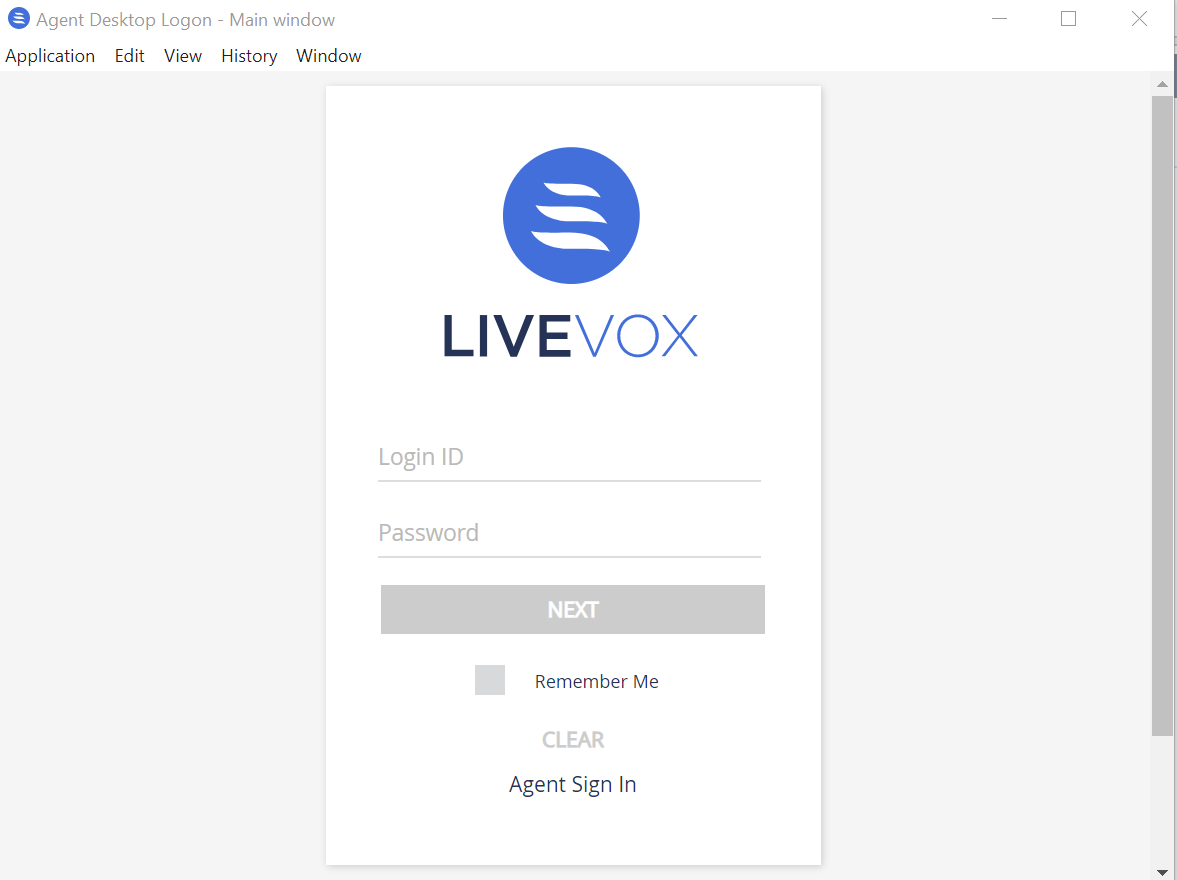 | Info |
|---|
- You can select the the Remember Me checkbox checkbox to save your your Login ID for for next logins. Your password will not be saved.
- You can use the the Clear option option to remove your entered credentials.
|
- In the the Service drop drop-down menu, select a service to which you want to log in, and then click click Sign In.

Depending on the selected service, the agent desktop prompts you to either dial in or connect using your computer audio via WebRTC.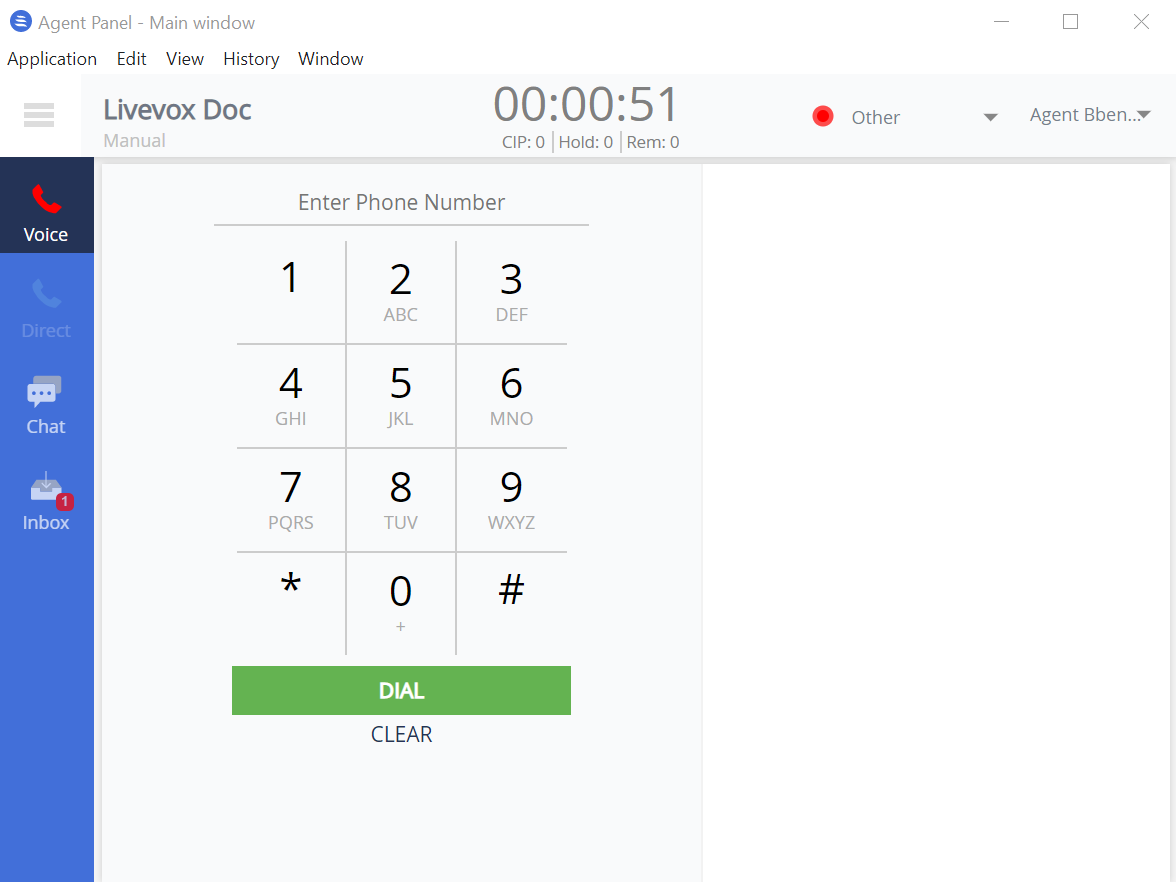 Image Modified Image ModifiedAgent Desktop Native Icon in System TrayOnce ADN application is installed, you can see the ADN icon in the system tray as below. This tray icon allows agents to do certain tasks even when the application is closed. | Note |
|---|
| When agents press the close (X) button in the upper right hand corner of ADN application, it doesn't completely quit the ADN application. It minimize the application into the lower right hand corner (system tray). This keeps agents logged logged in and they are be able to accept phone calls. |
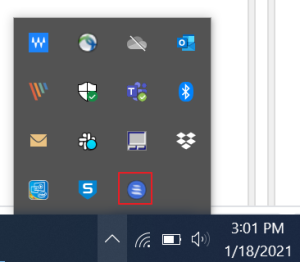 Image Modified Image Modified
The icon color will change depending on the agent state. The below table shows icons for different for different agents states. | Icon | Description |
|---|
 Image Modified Image Modified | Default |  Image Modified Image Modified | Agent is in Ready state |  Image Modified Image Modified | Agent is in Not Ready state |  Image Modified Image Modified | Agent is in call |  Image Modified Image Modified | Agent is in Hold state |  Image Modified Image Modified | Agent is in Preview Dial |  Image Modified Image Modified | Agent is getting the inbound call |  Image Modified Image Modified | Agent is in Wrap Up state |  Image Modified Image Modified | Agent is online |  Image Modified Image Modified | Agent is offline |
In addition, agents are displayed the icon with red dot when there is a new chat notification.
For example, an agent is in ready state and gets a message from another agent, then the agent gets the notification and this is indicated on the ready state icon with red dot.  Image Modified Image Modified
When agents right click on the tray icon, they are provided the below options:  Image Modified Image ModifiedAgent Desktop Native FunctionalityThe Agent Desktop Native application contains the same functionality as the Agent Desktop application on the browser. For more information, see the the Agent User Guide on on User Hub. Image Modified Image ModifiedADN LogsYou can view errors reported when performing the ADN operations at the following locations locations on the respective OS versions:- Windows: %USERPROFILE%\AppData\Roaming\Agent Desktop Native\logs\
- macOS: ~/Library/Logs/Agent Desktop Native/
- Linux: ~/.config/Agent Desktop Native/logs/
|